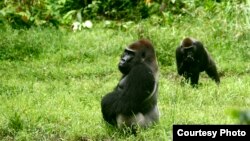Scientists are developing an Ebola vaccine for apes that’s designed to protect humans from future outbreaks. While still a number of years off, researchers say the vaccine offers a “win-win” solution for both species, that are sickened and die of Ebola.
The handling and consumption of bushmeat -- meat from wild, non-domesticated animals - is a common occurrence in Africa, particularly in the Congo Basin. It's believed meat from an ape infected by the Ebola virus first passed the deadly disease to humans in 1976. There have been more than 20 outbreaks since then.
The current Ebola crisis in Western Africa has sickened and killed as many as 10,000 people since last year. It was in all likelihood caused by contact with infected fruit bats in urban areas with poor infrastructure.
Apes and other primates can become infected when they eat fruit that’s fallen on to the jungle floor contaminated by bat droppings.
In an attempt to stem future Ebola outbreaks, scientists are developing what they call a “disseminating” vaccine to prevent the disease in Western Lowland Gorillas, a favored bushmeat source.
A harmless microbe called cytomegalovirus is the vehicle for the Ebola vaccine. Almost all mammals are infected by cytomegalovirus beginning at a young age, offering the potential for wide coverage.
Michael Jarvis is a virologist at Plymouth University in England who helped develop the primate vaccine, which would be delivered to wild apes by a blowdart.
Jarvis and colleagues describe the strategy in the journal Vaccine. “Most of the attraction of this approach is that you would do that for a few animals and then you would rely upon of the dissemination aspect of the virus to do the rest of the work for you,” he explained.
So far, the vaccine has been shown to work well in mice that are challenged with Ebola. Investigators are now conducting a study using rhesus macaque monkeys.
Ebola kills an estimated 30 percent of Lowland Gorillas, one reason the species is on the endangered list.
Jarvis said a disseminating vaccine could go a long way toward protecting the gorillas - and controlling future Ebola outbreaks. “About 30 percent of the 20 or so outbreaks [of Ebola] that have occurred have been directly from handling Great Ape carcasses,” he stated. “So, what this will do is potentially decrease the frequency of transmissions and outbreaks into the human population in the future.”
Still to be determined is how much protection the Ebola vaccine gives apes that have not been directly inoculated, but have been infected with the vaccine from primates that were treated.
If everything goes according to plan, Jarvis said a vaccine, shielding Apes and other primates from Ebola, could become available in three to four years.








